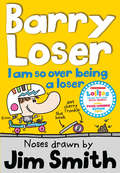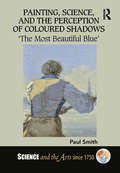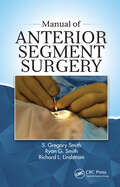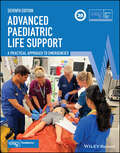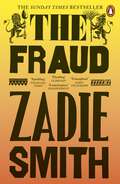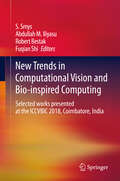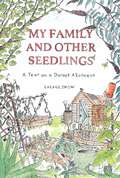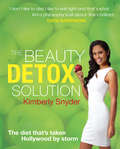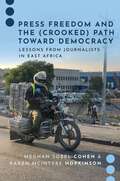- Table View
- List View
I am so over being a Loser: I Am So Over Being A Loser (Barry Loser #3)
by null Jim SmithRoald Dahl Funny Prize-winning series, perfect for fans of Dennis the Menace, Diary of a Wimpy Kid, Tom Gates, and Mr Gum. ‘My mum’s embarrassing enough just being my mum, but now she’s won The Voice of Feeko’s competition it’s even worse.’ Barry’s mum has become a bit of celebrity, and now he can’t go anywhere without seeing a poster of her eating a chocolate digestive or wiggling her bum in a pair of jeans. It’s so annoy-embarrassing, and everyone at school is making fun of him. Have you got all of Jim Smith’s amazekeel books? I am not a Loser I am still not a Loser I am so over being a Loser I am sort of a Loser Barry Loser and the holiday of doom Barry Loser and the case of the crumpled carton Barry Loser’s ultimate book of keelness Barry Loser hates half term Future Ratboy and the attack of the killer robot grannies Jim Smith is the keelest kids’ book author in the whole wide world amen. He graduated from art school with first class honours (the best you can get) and went on to create the branding for a sweet little chain of coffee shops. He also designs cards and gifts under the name Waldo Pancake.
Rural: The Lives of the Working Class Countryside
by null Rebecca Smith‘Eye-opening and persuasive’ SUNDAY TIMES ‘Brilliant … I loved it’ KIT DE WAAL ‘Thoughtful, moving, honest’ CAL FLYN Work in the countryside ties you, soul and salary, to the land. But often those who labour in nature have the least control over what happens there. Why have our rural industries been replaced by tourism? Why can't people stay living in the places they grew up? In this beautifully observed book, Rebecca Smith traces the stories of foresters and millworkers, miners, builders, farmers and pub owners, to paint a picture of the working class lives that often go overlooked. This is a book for anyone who loves and longs for the countryside.
Painting, Science, and the Perception of Coloured Shadows: ‘The Most Beautiful Blue’ (Science and the Arts since 1750)
by Paul SmithMany artists and scientists – including Buffon, Goethe, and Philipp Otto Runge – who observed the vividly coloured shadows that appear outdoors around dawn and dusk, or indoors when a candle burns under waning daylight, chose to describe their colours as ‘beautiful’. Paul Smith explains what makes these ephemeral effects worthy of such appreciation – or how depictions of coloured shadows have genuine aesthetic and epistemological significance. This multidisciplinary book synthesises methodologies drawn from art history (close pictorial analysis), psychology and neuroscience (theories of colour constancy), history of science (the changing paradigms used to explain coloured shadows), and philosophy (theories of perception and aesthetic value drawn from Wittgenstein and Merleau-Ponty). This title will be of interest to scholars in art history, art theory, and the history of science and technology.
Manual of Anterior Segment Surgery
by S Gregory Smith Ryan Smith Richard LindstromMicroscopic surgery requires complicated maneuvers. There are often photos, videos, and descriptions of what the instruments are doing. However, there are ways to set yourself up for success in ophthalmic surgical techniques. Inside the Manual of Anterior Segment Surgery is the wisdom of over 4 decades of surgical experience by Drs. Gregory Smith, Ryan Smith, and Richard Lindstrom covering the essentials of anterior segment surgery. Through this experience, one of the key ingredients in setting yourself up for success is the position of your hands with relation to the instrument and what you are trying to accomplish with the instrument. In a concise yet detailed manner, the basics of microscope management, patient head position, surgeon hand position, the relationship of the instrument and the hands, and how to enhance the performance of every surgical maneuver are covered with helpful illustrations. Designed to enhance your surgical techniques by putting you in a position to succeed, this manual will show you how to make the complex maneuvers look simple and improve patient outcomes. The Manual of Anterior Segment Surgery is a method to shorten your timeline to excellent surgery
Manual of Anterior Segment Surgery
by S Gregory Smith Ryan Smith Richard LindstromMicroscopic surgery requires complicated maneuvers. There are often photos, videos, and descriptions of what the instruments are doing. However, there are ways to set yourself up for success in ophthalmic surgical techniques. Inside the Manual of Anterior Segment Surgery is the wisdom of over 4 decades of surgical experience by Drs. Gregory Smith, Ryan Smith, and Richard Lindstrom covering the essentials of anterior segment surgery. Through this experience, one of the key ingredients in setting yourself up for success is the position of your hands with relation to the instrument and what you are trying to accomplish with the instrument. In a concise yet detailed manner, the basics of microscope management, patient head position, surgeon hand position, the relationship of the instrument and the hands, and how to enhance the performance of every surgical maneuver are covered with helpful illustrations. Designed to enhance your surgical techniques by putting you in a position to succeed, this manual will show you how to make the complex maneuvers look simple and improve patient outcomes. The Manual of Anterior Segment Surgery is a method to shorten your timeline to excellent surgery
Pediatric Stroke Rehabilitation: An Interprofessional and Collaborative Approach
by Sabrina Smith Heather Atkinson Kim Nixon-CavePediatric Stroke Rehabilitation: An Interprofessional and Collaborative Approach is a groundbreaking text designed to enhance the practice of all health care providers, enrich discussion, and emphasize the interdisciplinary nature of managing best outcomes for a child who has had a stroke. Evidence-based practice is threaded throughout the text with an emphasis on recovery vs. compensation, goal achievement, and outcome measurement.In conjunction with the interdisciplinary contributions from a wide variety of health care professionals, Drs. Heather Atkinson, Kim Nixon-Cave, and Sabrina E. Smith aim to provide the necessary tools to effectively treat children with stroke.The first section reviews the medical fundamentals, covering all major types of strokes. The second section of Pediatric Stroke Rehabilitation focuses on the core of the matter, rehabilitation. The final section expands the understanding of the child’s recovery to the family, community, and school environment.Select chapters include: Personal vignettes written by family members of children who have had a stroke that provides insight into the impact a stroke can have on the child and family A family focus box to summarize the main points of the chapter to provide the best tools for caregivers to advocate for their child A case study related to the content and family perspective Pediatric Stroke Rehabilitation also utilizes the World Health Organization’s International Classification of Functioning, Disability, and Health (ICF) framework throughout.Included with the text are online supplemental materials for faculty use in the classroom.Pediatric Stroke Rehabilitation: An Interprofessional and Collaborative Approach is an interdisciplinary and invaluable resource for students and clinicians to understand and apply effective evidence-based practice and treatment approaches for childhood stroke. The text will also be of interest to healthcare professionals, specifically physical therapists, occupational therapists, speech-language pathologists, physicians, neuropsychologists, nurses, and educators, who work with children who have experienced a stroke.
Pediatric Stroke Rehabilitation: An Interprofessional and Collaborative Approach
by Sabrina Smith Heather Atkinson Kim Nixon-CavePediatric Stroke Rehabilitation: An Interprofessional and Collaborative Approach is a groundbreaking text designed to enhance the practice of all health care providers, enrich discussion, and emphasize the interdisciplinary nature of managing best outcomes for a child who has had a stroke. Evidence-based practice is threaded throughout the text with an emphasis on recovery vs. compensation, goal achievement, and outcome measurement.In conjunction with the interdisciplinary contributions from a wide variety of health care professionals, Drs. Heather Atkinson, Kim Nixon-Cave, and Sabrina E. Smith aim to provide the necessary tools to effectively treat children with stroke.The first section reviews the medical fundamentals, covering all major types of strokes. The second section of Pediatric Stroke Rehabilitation focuses on the core of the matter, rehabilitation. The final section expands the understanding of the child’s recovery to the family, community, and school environment.Select chapters include: Personal vignettes written by family members of children who have had a stroke that provides insight into the impact a stroke can have on the child and family A family focus box to summarize the main points of the chapter to provide the best tools for caregivers to advocate for their child A case study related to the content and family perspective Pediatric Stroke Rehabilitation also utilizes the World Health Organization’s International Classification of Functioning, Disability, and Health (ICF) framework throughout.Included with the text are online supplemental materials for faculty use in the classroom.Pediatric Stroke Rehabilitation: An Interprofessional and Collaborative Approach is an interdisciplinary and invaluable resource for students and clinicians to understand and apply effective evidence-based practice and treatment approaches for childhood stroke. The text will also be of interest to healthcare professionals, specifically physical therapists, occupational therapists, speech-language pathologists, physicians, neuropsychologists, nurses, and educators, who work with children who have experienced a stroke.
Advanced Paediatric Life Support: A Practical Approach to Emergencies (Advanced Life Support Group)
by Stephanie SmithADVANCED PAEDIATRIC LIFE SUPPORT A PRACTICAL APPROACH TO EMERGENCIES The gold standard for treating paediatric emergencies Advanced Paediatric Life Support: A Practical Approach to Emergencies is the internationally renowned manual on emergency paediatric care. Written to support the course run by the Advanced Life Support Group, the book uses their structured approach: a tried and tested practical method of treating children during the crucial first few hours of a life-threatening illness or injury. Advanced Paediatric Life Support is used by doctors, nurses and allied health professionals dealing with emergencies in children. Its clear layout and straightforward style make it a highly practical tool both for training and in the event of an emergency. In the seventh edition you will find descriptions of both common and uncommon paediatric emergencies which you may encounter in clinical practice, their causes, and how to best treat them during the first hours after presentation. This book offers a thoroughly evidence-based approach to its subject, which includes: The latest International Liaison Committee on Resuscitation (ILCOR) 2021 guidelines A thorough introduction to the structured approach to paediatric emergencies, including important non-technical skills and communication Comprehensive explorations of the seriously ill child, including airway and breathing, circulation, decreased consciousness, seizures and exposure Practical discussions of the seriously injured child, including examinations of chest, abdominal, brain and spinal injuries Evidence-based life support treatment and the practical application of the Advanced Paediatric Life Support structured management Perfect for emergency care physicians, nurses and other allied health professionals, Advanced Paediatric Life Support: A Practical Approach to Emergencies will also benefit paediatric clinicians, doctors-in-training and anyone else with an interest in the team management and treatment of paediatric emergencies.
The Fraud: The instant Sunday Times bestseller
by Zadie SmithBook of the Year 2023 according to New York Times, New Yorker, Guardian, Economist, Observer, The Spectator, Financial Times, Vogue, The Times, The Oldie, i Paper, The Standard, Washington Post, Independent, Daily ExpressSHORTLISTED FOR WATERSTONES BOOK OF THE YEAR 2023SHORTLISTED FOR THE WRITERS’ PRIZE FOR FICTION 2024ONE OF SARAH JESSICA PARKER’S BEST BOOKS OF 2023LONGLISTED FOR THE WALTER SCOTT PRIZE FOR HISTORICAL FICTION 2024‘A writer at the peak of her powers’ The TelegraphTruth and fiction. Jamaica and Britain. Who gets to tell their story?In her first historical novel, Zadie Smith transports the reader to a Victorian England transfixed by the real-life trial of the Tichborne Claimant, in which a cockney butcher, recently returned from Australia, lays claim to the Tichborne baronetcy, with his former slave Andrew Bogle as star witness. Watching the proceedings, and with her own story to tell, is Eliza Touchet – cousin, housekeeper and perhaps more – to failing novelist William Harrison Ainsworth.From literary London to the Jamaica’s sugar-cane plantations, Zadie Smith weaves an enthralling story linking the rich and the poor, the free and the enslaved, and the comic and the tragic.‘It’s difficult to give any idea of how extraordinary this book is. One of the great historical novels, certainly. But has any historical novel ever combined such brilliantly researched and detailed history with such intensely imagined fiction?' Michael Frayn‘As always it is a pleasure to be in Zadie Smith’s mind . . . Dickens may be dead, but Smith, thankfully, is alive’ New York Times‘Zadie Smith’s Victorian-set masterpiece holds a mirror up to Britain . . . The Fraud is the genuine article’ Independent‘Smith’s dazzling historical novel combines deft writing and strenuous construction in a tale of literary London and the horrors of slavery’ Guardian
Keir Hardie, the Bible, and Christian Socialism: The Miner's Prophet (The Library of New Testament Studies)
by Professor Daniel L. Smith-ChristopherDaniel L. Smith-Christopher focuses on the life and efforts of Keir Hardie, one of the founders of the UK Labour Party and one of the foremost figureheads of trade unionism. Drawing upon the work of two contemporary and significant American theorists-Herbert Gutman's classic essay on “Working-Class Religion” and Michael Gold's call for “Proletarian Literature”-Smith-Christopher marries British and American historical and theoretical debates to argue that Hardie's work is surely the quintessential example of a “proletarian exegesis” of the Bible.Beginning with a summary of the major events in Hardie's life, Smith-Christopher draws both upon existing biographies and more recent historical discussions that question assumption of British social history. He then reviews previous debates upon the influence of Hardie's own Christian faith upon his journalistic output, and assesses three Christian Socialists whose work was advertised and reviewed by Hardie himself: Dennis Hird, John Morrison Davidson, and Caroline Martyn. Smith-Christopher proceeds to Hardie's copious writings, both for The Labour Leader and separately published lectures, pamphlets, and somewhat longer works of autobiography and comment. Highlighting Hardie's tendency to cite favorite texts (heavily from the Gospels and James, but also some notable Old Testament discussions), Smith-Christopher proves Hardie's serious discussion of these texts beyond mere political rhetoric; concluding by comparing a selection of Hardie's favorite Biblical arguments with contemporary research in Biblical Studies about these same passages, evaluating the problems and possibilities of proposing a “Proletarian Exegesis”.
Keir Hardie, the Bible, and Christian Socialism: The Miner's Prophet (The Library of New Testament Studies)
by Professor Daniel L. Smith-ChristopherDaniel L. Smith-Christopher focuses on the life and efforts of Keir Hardie, one of the founders of the UK Labour Party and one of the foremost figureheads of trade unionism. Drawing upon the work of two contemporary and significant American theorists-Herbert Gutman's classic essay on “Working-Class Religion” and Michael Gold's call for “Proletarian Literature”-Smith-Christopher marries British and American historical and theoretical debates to argue that Hardie's work is surely the quintessential example of a “proletarian exegesis” of the Bible.Beginning with a summary of the major events in Hardie's life, Smith-Christopher draws both upon existing biographies and more recent historical discussions that question assumption of British social history. He then reviews previous debates upon the influence of Hardie's own Christian faith upon his journalistic output, and assesses three Christian Socialists whose work was advertised and reviewed by Hardie himself: Dennis Hird, John Morrison Davidson, and Caroline Martyn. Smith-Christopher proceeds to Hardie's copious writings, both for The Labour Leader and separately published lectures, pamphlets, and somewhat longer works of autobiography and comment. Highlighting Hardie's tendency to cite favorite texts (heavily from the Gospels and James, but also some notable Old Testament discussions), Smith-Christopher proves Hardie's serious discussion of these texts beyond mere political rhetoric; concluding by comparing a selection of Hardie's favorite Biblical arguments with contemporary research in Biblical Studies about these same passages, evaluating the problems and possibilities of proposing a “Proletarian Exegesis”.
Post-Quantum Cryptography: 15th International Workshop, PQCrypto 2024, Oxford, UK, June 12–14, 2024, Proceedings, Part II (Lecture Notes in Computer Science #14772)
by Daniel Smith-Tone Markku-Juhani SaarinenThe two-volume set LNCS 14771 and 14772 constitutes the refereed proceedings of the 15th International Workshop, PQCrypto 2024, held in Oxford, UK, during June 12–14, 2024. The 28 full papers included in these proceedings were carefully reviewed and selected from 76 submissions. They were organized in topical sections as follows: Part I: Applications and protocols; code-based cryptography; group-action-based cryptography; lattice-based cryptography; Part II: Isogeny-Based cryptgraphy; multivariate cryptography; quantum algorithms; transforms and proofs.
Christ the Emperor: Christian Theology and the Roman Emperor in the Fourth Century AD (Oxford Studies in Late Antiquity)
by Nathan Israel SmolinPolitics and diplomacy have always been as much about the social and cultural contexts within which political actors operate as they are about the political structures themselves. This was also true of the Roman Empire of the fourth century AD, ruled by the Emperor Constantine the Great--a society marked by social, religious, and political transformation as the empire came under the influence of the Christian Church. Studies of this period often note the difficulty of understanding its politics due to a lack of sources that discuss questions central to political theory. This has led to deprecating views of the Late Empire as an age of unquestioning despotism, political decline, and social decay. Recent scholarship has correctly pushed back against this viewpoint, emphasizing the vibrancy of art, architecture, and social life during this period; however, relatively little attention has yet been given to the deeply consequential effects of Christian theology on the period's politics. Christ the Emperor argues that the alleged absence of explicit political theorizing in fourth century texts is the result of a migration of these discourses from the realm of "secular" politics to that of public Christian theology, where questions fundamental to political theory were analyzed and debated in more far-reaching ways than ever before. When fourth century bishops and Emperors wished to discuss the pressing questions of legitimacy, succession, hierarchy, equality, unity, diversity, and power, they did so largely in and through Christian theology. To understand how these political and social actors thought about and enacted political theory, Nathan Israel Smolin turns to theological sources. In doing so, he reveals this period as one of profound political, social, and religious ferment, in which ideas and structures fundamental to the history of the following millennia were developed and contested--ideas that continue to shape our world today.
Christ the Emperor: Christian Theology and the Roman Emperor in the Fourth Century AD (Oxford Studies in Late Antiquity)
by Nathan Israel SmolinPolitics and diplomacy have always been as much about the social and cultural contexts within which political actors operate as they are about the political structures themselves. This was also true of the Roman Empire of the fourth century AD, ruled by the Emperor Constantine the Great--a society marked by social, religious, and political transformation as the empire came under the influence of the Christian Church. Studies of this period often note the difficulty of understanding its politics due to a lack of sources that discuss questions central to political theory. This has led to deprecating views of the Late Empire as an age of unquestioning despotism, political decline, and social decay. Recent scholarship has correctly pushed back against this viewpoint, emphasizing the vibrancy of art, architecture, and social life during this period; however, relatively little attention has yet been given to the deeply consequential effects of Christian theology on the period's politics. Christ the Emperor argues that the alleged absence of explicit political theorizing in fourth century texts is the result of a migration of these discourses from the realm of "secular" politics to that of public Christian theology, where questions fundamental to political theory were analyzed and debated in more far-reaching ways than ever before. When fourth century bishops and Emperors wished to discuss the pressing questions of legitimacy, succession, hierarchy, equality, unity, diversity, and power, they did so largely in and through Christian theology. To understand how these political and social actors thought about and enacted political theory, Nathan Israel Smolin turns to theological sources. In doing so, he reveals this period as one of profound political, social, and religious ferment, in which ideas and structures fundamental to the history of the following millennia were developed and contested--ideas that continue to shape our world today.
New Trends in Computational Vision and Bio-inspired Computing: Selected works presented at the ICCVBIC 2018, Coimbatore, India
by S. Smys Robert Bestak Fuqian Shi Abdullah M. IliyasuThis volume gathers selected, peer-reviewed original contributions presented at the International Conference on Computational Vision and Bio-inspired Computing (ICCVBIC) conference which was held in Coimbatore, India, on November 29-30, 2018. The works included here offer a rich and diverse sampling of recent developments in the fields of Computational Vision, Fuzzy, Image Processing and Bio-inspired Computing. The topics covered include computer vision; cryptography and digital privacy; machine learning and artificial neural networks; genetic algorithms and computational intelligence; the Internet of Things; and biometric systems, to name but a few. The applications discussed range from security, healthcare and epidemic control to urban computing, agriculture and robotics.In this book, researchers, graduate students and professionals will find innovative solutions to real-world problems in industry and society as a whole, together with inspirations for further research.
Lie Low (Modern Plays)
by Ciara Elizabeth SmythI was broken into a year ago and I was struggling for a bit afterwards. I'm fine now though.In the wake of a home invasion, Faye can't sleep. She's fine though. All she's had to eat this week is a box of dry Rice Krispies. She's fine though, really – she is…Desperate to shake her insomnia, Faye enlists the help of her brother, Naoise, to try a form of exposure therapy. But Naoise has a devastating secret that's about to come to light. Lie Low is a dark new play from writer Ciara Elizabeth Smyth about fear, trauma and family, offering a theatrical exploration into the human brain and its response to sexual assault. This edition was coincide with the London premiere at the Royal Court, in May 2024.
Lie Low (Modern Plays)
by Ciara Elizabeth SmythI was broken into a year ago and I was struggling for a bit afterwards. I'm fine now though.In the wake of a home invasion, Faye can't sleep. She's fine though. All she's had to eat this week is a box of dry Rice Krispies. She's fine though, really – she is…Desperate to shake her insomnia, Faye enlists the help of her brother, Naoise, to try a form of exposure therapy. But Naoise has a devastating secret that's about to come to light. Lie Low is a dark new play from writer Ciara Elizabeth Smyth about fear, trauma and family, offering a theatrical exploration into the human brain and its response to sexual assault. This edition was coincide with the London premiere at the Royal Court, in May 2024.
My Family and Other Seedlings: A Year on a Dorset Allotment
by Lalage SnowA few years ago Lally Snow moved to a Dorset village with her husband and three small children, having spent over a decade as a war photographer, foreign correspondent and film maker living in Kabul. She covered the conflict there as well as other wars from Gaza to Eastern Ukraine, and Iraq.In the late winter of 2021-22, Lally decided to rent an allotment, despite having only a rudimentary knowledge of gardening. She was starting from scratch and setting herself the dual challenge of growing an allotment at the same time as growing a family.This is a heart-warming, wry and at times tearful account of Lally's travails as a mother and novice allotment holder, counterpointing horticultural progress with the perils of parenting. Along the way she reflects on the drudgery of English rural domesticity after a professional life chasing war and adventure, the history of the allotment since Saxon times, and the wonderful moment when gardening becomes fun rather than just feeding a family.
The Sixth Element: How Carbon Shapes Our World
by Theodore P. Snow Don BrownleeA cosmic perspective on carbon—its importance in the universe and our livesWhen we think of carbon, we might first think of a simple element near the top of the periodic table: symbol C, atomic number 6. Alternatively, we might think of something more tangible—a sooty piece of coal or a sparkling diamond, both made of carbon. Or, as Earth&’s temperature continues to rise alarmingly, we might think of the role carbon plays in climate change. Yet carbon&’s story begins long ago, far from earthly concerns. In The Sixth Element, astronomers Theodore Snow and Don Brownlee tell the story of carbon from a cosmic perspective—how it was born in the fiery furnaces of stars, what special chemical and physical properties it has, and how it forms the chemical backbone of the planets and all life as we know it. Foundational to every part of our lives, from our bodies to the food, tools, and atmosphere that sustain our existence, carbon is arguably humankind&’s most important element.Snow and Brownlee offer readers the ideal introduction to the starry element that made our world possible and shapes our lives. They first discuss carbon&’s origin, discovery, and unique ability to bond with other elements and form countless molecules. Next, they reveal carbon&’s essential role in the chemical evolution of the universe and the formation and evolution of galaxies, stars, planets, and life, and then, more generally, its technological uses and its influence on Earth&’s climate. Bringing readers on a historical, scientific, and cross-disciplinary journey, The Sixth Element illuminates the cosmic wonder that is carbon.
The Sixth Element: How Carbon Shapes Our World
by Theodore P. Snow Don BrownleeA cosmic perspective on carbon—its importance in the universe and our livesWhen we think of carbon, we might first think of a simple element near the top of the periodic table: symbol C, atomic number 6. Alternatively, we might think of something more tangible—a sooty piece of coal or a sparkling diamond, both made of carbon. Or, as Earth&’s temperature continues to rise alarmingly, we might think of the role carbon plays in climate change. Yet carbon&’s story begins long ago, far from earthly concerns. In The Sixth Element, astronomers Theodore Snow and Don Brownlee tell the story of carbon from a cosmic perspective—how it was born in the fiery furnaces of stars, what special chemical and physical properties it has, and how it forms the chemical backbone of the planets and all life as we know it. Foundational to every part of our lives, from our bodies to the food, tools, and atmosphere that sustain our existence, carbon is arguably humankind&’s most important element.Snow and Brownlee offer readers the ideal introduction to the starry element that made our world possible and shapes our lives. They first discuss carbon&’s origin, discovery, and unique ability to bond with other elements and form countless molecules. Next, they reveal carbon&’s essential role in the chemical evolution of the universe and the formation and evolution of galaxies, stars, planets, and life, and then, more generally, its technological uses and its influence on Earth&’s climate. Bringing readers on a historical, scientific, and cross-disciplinary journey, The Sixth Element illuminates the cosmic wonder that is carbon.
Reasserting America in the 1970s: U.S. public diplomacy and the rebuilding of America’s image abroad (Key Studies in Diplomacy)
by David J. Snyder Giles Scott-Smith Hallvard NotakerReasserting America in the 1970s brings together two areas of burgeoning scholarly interest. On the one hand, scholars are investigating the many ways in which the 1970s constituted a profound era of transition in the international order. The American defeat in Vietnam, the breakdown of the Bretton Woods exchange system and a string of domestic setbacks including Watergate, Three-Mile Island and reversals during the Carter years all contributed to a grand reappraisal of the power and prestige of the United States in the world. In addition, the rise of new global competitors such as Germany and Japan, the pursuit of détente with the Soviet Union and the emergence of new private sources of global power contributed to uncertainty.
The Beauty Detox Solution: The Diet That Has Taken Hollywood By Storm (Harlequin Non-fiction Ser.)
by null Kimberly SnyderLooking for the ultimate secret to health and beauty? Don’t look in your medicine cabinet. Look here. Celebrity nutritionist and beauty expert Kimberly Snyder helps dozens of Hollywood’s Alist stars get redcarpet ready—and now you’re getting the star treatment. Kim used to struggle with coarse hair, breakouts and stubborn belly fat, until she traveled the world, learning ageold beauty secrets. She discovered that what you eat is the ultimate beauty product, and she’s developed a powerful program that rids the body of toxins so you can look and feel your very best. With just a few simple diet changes, you will: Get a youthful, radiant glow – Banish acne, splotchy skin and wrinkles – Grow lustrous hair and strong nails – Get rid of the bloat, melt away fat and never count calories again!
Press Freedom and the: Lessons from Journalists in East Africa (Journalism and Political Communication Unbound)
by Meghan Sobel Cohen Karen McIntyre HopkinsonMedia scholars generally suggest that as people gain access to mass media content, they increasingly support democracy and reject authoritarian rule. Much of the scholarship classifying global media systems has overlooked the world's most developing nations, and among those that have included developing nations, there exists a misguided premise that nations develop in a linear fashion: from non-democracy to democracy, and from a restricted press to a free press. This book shows that much of what scholarship depicts about media systems of developing nations is wrong. In reality, the ebb-and-flow of political change, democratization and backsliding calls for more historically informed views of media systems that do not fit into the confines of existing theories. Using the perceptions of journalists in Rwanda, Uganda, and Kenya to examine mediascapes at varying stages of development and democracy-building, this book examines the advancement of media and press freedom at varying stages of national development. Drawing on qualitative fieldwork and a cross-national survey, this book provides an updated state of press freedom in these three countries and shows how a nation's political and cultural intricacies complicate traditional media development frameworks and notions of press freedom. A detailed set of considerations are put forth for understanding media systems outside the Western world; specifically, that each country's distance from conflict, political benchmarks, international linkages, and civil society strength are central to understanding its degree of press freedom, development and democratization.
Press Freedom and the: Lessons from Journalists in East Africa (Journalism and Political Communication Unbound)
by Meghan Sobel Cohen Karen McIntyre HopkinsonMedia scholars generally suggest that as people gain access to mass media content, they increasingly support democracy and reject authoritarian rule. Much of the scholarship classifying global media systems has overlooked the world's most developing nations, and among those that have included developing nations, there exists a misguided premise that nations develop in a linear fashion: from non-democracy to democracy, and from a restricted press to a free press. This book shows that much of what scholarship depicts about media systems of developing nations is wrong. In reality, the ebb-and-flow of political change, democratization and backsliding calls for more historically informed views of media systems that do not fit into the confines of existing theories. Using the perceptions of journalists in Rwanda, Uganda, and Kenya to examine mediascapes at varying stages of development and democracy-building, this book examines the advancement of media and press freedom at varying stages of national development. Drawing on qualitative fieldwork and a cross-national survey, this book provides an updated state of press freedom in these three countries and shows how a nation's political and cultural intricacies complicate traditional media development frameworks and notions of press freedom. A detailed set of considerations are put forth for understanding media systems outside the Western world; specifically, that each country's distance from conflict, political benchmarks, international linkages, and civil society strength are central to understanding its degree of press freedom, development and democratization.
